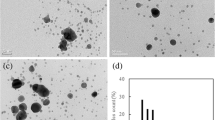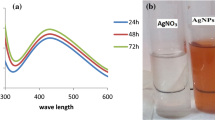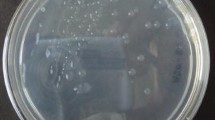Abstract
The biomass of Aeromonas SH10 was proven to strongly absorb Ag+ and [Ag(NH3)2]+. The maximum uptake of [Ag(NH3)2]+ was 0.23 g(Ag) g−1(cell dry weight), higher than that of Ag+. Fourier transform infrared spectroscopy spectra analysis indicated that some organic groups, such as amide and ionized carboxyl in the cell wall, played an important role in the process of biosorption. After SH10 cells were suspended in the aqueous solution of [Ag(NH3)2]+ under 60°C for more than 12 h, [Ag(NH3)2]+ was reduced to Ag(0), which was demonstrated by the characteristic absorbance peak of elemental silver nanoparticle in UV-VIS spectrum. Scanning electron microscopy and transmission electron microscopy observation showed that nanoparticles were formed on the cell wall after reduction. These particles were then confirmed to be elemental silver crystal by energy dispersive X-ray spectroscopy, X-ray diffraction, and UV-VIS analysis. This study demonstrated the potential use of Aeromonas SH10 in silver-containing wastewater treatment due to its high silver biosorption ability, and the potential application of bioreduction of [Ag(NH3)2]+ in nanoparticle preparation technology.




Similar content being viewed by others
References
Hilmi, A., Luong, J., & Nguyen, A. (1999). Utilization of TiO2 deposited on glass plates for removal of metals from aqueous wastes. Chemosphere, 38, 865–874.
Adani, K. G., Barley, R. W., & Pascoe, R. D. (2005). Silver recovery from synthetic photographic and medical X-ray process effluents using activated carbon. Mineral Engineering, 18, 1269–1276.
Othman, N., Mat, H., & Goto, M. (2006). Separation of silver from photographic wastes by emulsion liquid membrane system. Journal of Membrane Science, 282, 171–177.
Chen, J. P., & Lim, L. L. (2002). Key factors in chemical reduction by hydrazine for recovery of precious metals. Chemosphere, 49, 363–370.
Pollet, B., Lorimer, J. P., Phull, S. S., & Hihn, J. Y. (2000). Sonoelectrochemical recovery of silver from photographic processing solutions. Ultrasonics Sonochemistry, 7, 69–76.
Ajiwe, V. I. E., & Anyadiegwu, I. E. (2000). Recovery of silver from industrial wastes, cassava solution effects. Separation and Purification Technology, 18, 89–92.
Fourest, E., Canal, C., & Roux, J. (1994). Improvement of heavy metal biosorption by mycelial dead biomasses (Rhizopus arrhizus, Mucor miehei and Penicillium chrysogenum): pH control and cationic activation. FEMS Microbiology Reviews, 14, 325–332.
Pethkar, A. V., & Paknikar, K. M. (2003). Thiosulfate biodegradation–silver biosorption process for the treatment of photofilm processing wastewater. Process Biochemistry, 38, 855–860.
Simmons, P., & Singleton, I. (1996). A method to increase silver biosorption by an industrial strain of Saccharomyces cerevisiae. Applied Microbiology and Biotechnology, 45, 278–285.
Mukherjee, P., Ahmad, A., Mandal, D., Senapati, S., Sainkar, S. R., Khan, M. I., et al. (2001). Fungus-Mediated Synthesis of Silver Nanoparticles and Their Immobilization in the Mycelial Matrix: A Novel Biological Approach to Nanoparticle Synthesis. Nano Letters, 1, 515–519.
Ahmad, A., Mukherjee, P., Senapati, S., Mandal, D., Khan, M. I., Kumar, R., et al. (2003). Extracellular biosynthesis of silver nanoparticles using the fungus Fusarium oxysporum. Colloids and Surfaces B, 28, 313–318.
Klaus, T., Joerger, R., Olsson, E., & Granqvist, C. G. (1999). Silver-based crystalline nanoparticles, microbially fabricated. Proceedings of the National Academy of Sciences of the United States of America, 96, 13611–13614.
Fu, J., Liu, Y., Gu, P., Tang, D., Lin, Z., Yao, B., et al. (2000). Spectroscopic characterization on the biosorption and bioreduction of Ag(1) by Lactobacillus sp. A09. Acta Physico-Chimica Sinica, 16, 779–782.
Lin, Z., Zhou, C., Wu, J., Zhou, J., & Wang, L. (2005). A further insight into the mechanism of Ag+ biosorption by Lactobacillus sp. strain A09, Spectrochimica Acta, 61, 1195–1200.
Zhang, H., Li, Q., Lu, Y., Sun, D., Lin, X., Deng, X., et al. (2005). Biosorption and bioreduction of diamine silver complex by Corynebacterium. Journal of Chemical Technology and Biothechnology, 80, 285–290.
Tobin, J. M., Cooper, D. G., & Neufeld, R. J. (1984). Uptake of Metal Ions by Rhizopus arrhizus Biomass. Applied and Environmental Microbiology, 47, 821–824.
Kapoor, S. (1998). Preparation, Characterization, and Surface Modification of Silver Particles. Langmuir, 14, 1021–1025.
Zhu, J. J., Liu, S. W., Palchik, O., Koltypin, Y., & Gedanken, A. (2000). Shape-Controlled Synthesis of Silver Nanoparticles by Pulse Sonoelectrochemical Methods. Langmuir, 16, 6396–6399.
Esumi, K., Hosoya, T., Suzuki, A., & Torigoe, K. (2000). Formation of Gold and Silver Nanoparticles in Aqueous Solution of Sugar-Persubstituted Poly(amidoamine) Dendrimers. Journal of Colloid and Interface Science, 226, 346–352.
Lee, M. H., Oh, S. G., Suh, K. D., Kim, D. G., & Sohn, D. (2002). Preparation of silver nanoparticles in hexagonal phase formed by nonionic Triton X-100 surfactant. Colloids and Surfaces A, 210, 49–60.
Acknowledgment
This work is part of the project (20376076) supported by National Natural Science Foundation of China. The authors thank Analysis and Testing Center of Xiamen University for the help of SEM and TEM analysis in this study.
Author information
Authors and Affiliations
Corresponding author
Rights and permissions
About this article
Cite this article
Zhang, H., Li, Q., Wang, H. et al. Accumulation of Silver(I) Ion and Diamine Silver Complex by Aeromonas SH10 biomass. Appl Biochem Biotechnol 143, 54–62 (2007). https://doi.org/10.1007/s12010-007-8006-1
Received:
Accepted:
Published:
Issue Date:
DOI: https://doi.org/10.1007/s12010-007-8006-1




